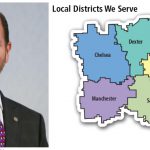With the Bureau of Labor Statistic’s “Employment Situation” release for April 2017 scheduled for Friday morning, we thought a follow-up on our recent Lamppost on unemployment statistics was in order, in the form of a quick look back at some recent numbers.
The BLS website has the Employment Situation releases archived back to 1994, but we’ll just be looking at the numbers for January, February, and March of 2017. Each release contains a few pages of FAQs and technical notes, but the majority of each one is made up of dozens of tables breaking down the household survey and workplace survey data into a bewildering number of labor sub-markets and demographic groupings. Sticking with our primary interests, we’ll look at the U-3 and U-6 unemployment rates from the household survey, along with the numbers that make them up.
January | February | March | |
U-3 Unemployment Rate | 4.8% | 4.7% | 4.5% |
U-6 Unemployment Rate | 9.4% | 9.2% | 8.9% |
Civilian Noninstitutional Population* | 254,082 | 254,246 | 254,414 |
Civilian Labor Force | 159,716 | 160,056 | 160,201 |
Employed | 152,081 | 152,528 | 153,000 |
Unemployed | 7,635 | 7,528 | 7,202 |
Employment-Population Ratio | 59.9% | 60.0% | 60.1% |
Part-time for Economic Reasons | 5,840 | 5,704 | 5,553 |
Marginally Attached to Workforce | 1,752 | 1,723 | 1,595 |
| 532 | 522 | 460 |
* All numbers are in thousands |
So, just as a refresher, U-3 is the official unemployment rate, and is the ratio of the Unemployed to Civilian Labor Force numbers in the chart above; for January we get 7,635/159,716 =0.478, which rounds to the 4.8% shown above. U-6 is messier, a measure of how many people want to work full-time but aren’t able to: it’s the ratio of (Unemployed + Part-time for Economic Reasons + Marginally Attached) to (Civilian Labor Force + Part-Time for Economic Reasons + Marginally Attached).
It’s important to note that there can be noise in unemployment numbers due to unusual weather, natural disasters, and other short-term events, so it’s usually important to look at trends rather than individual months, even if it’s only looking across a few months as we’re doing here. With that said, these numbers are relatively favorable. Unlike some cases where various indicators can move in different directions, the Employed numbers have risen consistently while the Unemployed and other “unhappy people” numbers have all dropped, with the Marginally Attached to Workforce folks dropping particularly quickly in March – about 10% of the people who’d been employed spottily over the last 12 months were able to join the workforce full time that month.
As mentioned in the Lamppost article, a U-3 rate of below 5% is typically expected to lead to rising inflation, so the fact we’re hitting 4.5% is part of why the Fed has raised interest rates recently. However, since wage rates have yet to rise significantly, and since inflation is still bumbling along below 2%, a case can be made that the Fed is emphasizing their inflation prevention role at the cost of the middle class and working poor, who haven’t seen any real progress in wages since the boom of the late 1990s.
Still, if these employment trends continue into April President Trump will have a bit of a tailwind in his favor. Then again, so will American workers. Politics aside, there is very little that a president can do to impact employment this soon after inauguration without aggressive legislation like the American Recovery and Reinvestment Act, which was able to halt the post-crash employment freefall at about this point in President Obama’s first term, but at a price tag in the hundreds of billions. With a government shutdown out of the picture for a few months1, there isn’t likely to be a dramatic negative shift in employment due to a halt to government spending, either. So while the numbers on Friday may be better or worse than we’ve seen over the last few months, they shouldn’t be dramatically so.
David is one of the earliest writers for Torchlight, and also pinch hits on website support and editing/posting. He holds a PhD in Economics, which with $5 would get him a latte; sadly, he doesn’t even like coffee. He can be reached at dspitzley@torchlightmedia.net.


